This is another of those ponderous, philosophical posts – I’ll try to follow up with pics and fewer words soon, I promise…
Given that we understand that evolution by natural selection is effective, in sometimes astounding ways, but also a bit haphazard and imprecise, questions sometimes arise about whether conscious decisions might be able to accomplish better results more directly. This subject has been tackled many times before, very early on actually, and one of the most loathed methods was the process of eugenics, practically a curse word in today’s culture. Yet the fundamental problems with the eugenics program(s) weren’t the goals, it was the huge misunderstanding of what genes can produce (as opposed to the post-genetic factors of upbringing and culture) and the methodology involved, which at times violated human rights and common decency. The movement also encouraged the common idea of being superior and privileged solely by existing, or to be more specific, solely because one was better genetic ‘stock’ than someone else, making it easy to be abused by our fragile egos.
The thing is, this concept of genetic superiority is actually quite valid, if one is careful to define their criteria and fully understands how the process works. Certain genetic variations do indeed produce organisms better suited to their environment than others, and the advantages incurred translate into better survival/reproduction and thus greater spread of those genes – this is entirely what natural selection is. And yes, we can take a hand in this; virtually all of our food plants and animals, even domesticated pet species and ornamental plants, have been “unnaturally” or “artificially” selected (both of those terms imply a lot of baggage not deserved) to be the species we’re familiar with – in most cases, to our benefit, though there are notable exceptions. Overall, however, the “wild” versions of our food grains were nowhere near as hardy nor produced as much usable product; the “natural” species of livestock were leaner and far less docile, quite inefficient as food sources or even labor elements. We’ve been up to this for a long time, and the beneficial results can only be argued with abject denial (which will still occur anyway…)
So what about humans, as a species? Is it possible, ethical, and effective to consider selective reproduction for ourselves? Ah, such a loaded question! There’s a lot to consider here.
First off, we already do – our choices of spouse (or even just sexual partners) really is self-selection, though we often remain unaware of the extent, or the subtle influences that inherent traits have on the process. So the question is more about how conscious we can/should be about the process, and whether we should have more direct goals than the basic urges – a dividing line between “natural” and “artificial” that’s really hard to define (you see what I mean about baggage?)
Second, we would really need to understand what factors are actually affected by genetic heritage. Marrying a highly intelligent person is unlikely, by itself, to produce a highly intelligent child (unless you have sex) because intelligence is produced by culture and upbringing, not genes to any significant extent. It would be nice to say we humans have moved away from decrepit ideas of other ‘races’ possessing traits of laziness or overeating or whatever, but this hasn’t really been demonstrated too well. So selective breeding isn’t likely to be functional in any way whenever it’s based on false premises and gross misunderstandings.
Despite all that, there are already rudimentary functions of this nature going on, from an effective basis as well. Genetic tests and even family history can give an indication of high risks for problematic children, letting the parents decide whether it’s a good idea to bear a child that is likely to struggle with problems or illnesses, such as cystic fibrosis or Tay-Sachs disease. Sometimes such considerations get bogged down in vapid, misdirected discussions such as “denying a child life” by not getting pregnant, as if there’s a stockpile of aware, pre-mortal lives waiting to be born someplace, or if genetic decisions are some method of trying to second-guess god, whose decisions are far more predictable through genetics than any method the devout have tried.
Given the myriad assumptions and misconceptions tied up in the topic, discussions of this nature become very difficult – either someone feels that the process shouldn’t be tampered with, or that it involves factors that really don’t apply (or both,) so things get bogged down very quickly. One can add in lots of other sidetracks like the fear of mutants or the belief that all scientific research results in terrible consequences – because, apparently, enough people get their knowledge of science from B-movies – and produce lively yet ridiculously pointless arguments.
Speaking of that, what are the ethical views of genetically engineering humans, occasionally referred to as “designer people”? Throw this question out in any gathering to watch the reaction; for fun, change up and insert the word “fetus” in another discussion. Take a stopwatch and see how long before the word “tamper” comes up in response (the watch had best be able to display hundredths of seconds.) A moment’s thought will demonstrate that this is absolutely no different from the breeding we’ve been doing on dogs and roses for centuries, but the idea that humans are in some way a special circumstance repeatedly rears its head; this goes doubly so for fetuses (feti?), though any genetic modifications would take place at the single-cell stage long before cell division, since genes affect development. But our sense of protection over infants, which is admittedly pretty important for survival, kicks in where it really doesn’t apply. People begin trying to draw an arbitrary line of where “life” begins to define where it’s improper to mess about – the same people who take painkillers and antibiotics and undergo laser surgery on their vision and all that jazz. Seriously, if you’re quick on the draw, you can while away many evenings by challenging other peoples’ perspectives. Granted, your group of friends may dwindle a bit…
And I have to add, any discussion of genetics in this manner assumes by the very topic that humans are just as evolved as everything else on earth – no pedestal for us. A lot more fun can be produced if you start challenging someone to define how we, as natural beings on this planet with naturally evolved brains, could possibly do something “unnatural” or “artificial,” any more than a spider that selects a mate.
It’s been asked quite often whether humans have actually stopped evolving; our advances in medicine, living conditions, and general knowledge of hazards has compensated for many of the conditions that killed us off, death being one of those tools of selection. The most prominent contributor to this idea is the burgeoning population of the planet, with the birth (survival) rate overtaking the death rate significantly. If human evolution really has stopped or slowed, even partially, it might make sense that we should take a hand in selectivity ourselves. Yet, this is applying the idea of evolution to a much briefer scale than it really operates. Evolution takes place in populations, which for us now is worldwide (a fun thought we’ll come back to,) over very long periods of time. Our population issues are quite capable of demonstrating that evolution has not stopped for humans, should we reach the point of starving ourselves, and what is likely to happen is that we develop far less desire to reproduce. This will take a long time; parents (genetic lines) that have lots of babies will spread their genes faster than those who have fewer, which is exactly the opposite of what we would want to happen, but in crucial areas with limited resources all of those children may starve (or have developmental issues through poor nutrition, and so on.) But if a prolific couple has just one of their many children live to reach reproductive age, this is exactly the same effect as the couple that desired and raised only one child – the genes that contributed to the urge for many children or one child are on an equal footing and pass along in this circumstance. Plus, there’s the idea that we are not geographically isolated anymore, so a newly-arising “limited children” gene may go anyplace on the planet, decreasing the likelihood of reinforcing itself within a small population; it stands a much greater chance of losing out to a more dominant gene and failing to be carried through to offspring. This makes the process much slower overall.
Yet, the necessary genes to limit populations may already be in effect – it’s easy to believe most parents would be wrecked with seeing their children die off and would tend not to reproduce quite so enthusiastically in situations where survival was highly questionable. Meanwhile, viruses that spread easily in crowded conditions only have to surpass a certain threshold of both immune resistance and host mortality to thwart our medical advantages; a pandemic is only less likely with our knowledge, not impossible. Plus zombies.
So the issue isn’t really that natural selection is no longer working, or even hampered; it’s that we would prefer to avoid the way it actually works, for instance, by replacing infant mortality with voluntary childbirth limits.
Now here’s another problem with conscious selection: few people would select against themselves. We already have traits to promote ourselves in numerous ways – put simply, ‘ego’ is the importance of the organism. Hell, we cannot even dispense with alcohol, tobacco, and handguns throughout our populations, despite the complete pointlessness of them, and I can predict that a large percentage of people reading that statement will formulate countless defenses of any or all of them, mostly based on imagined scenarios and in denial of the real-world evidence that proves the point. Such responses aren’t the product of rational consideration, but the internal prods towards a perceived beneficial outcome; “This gun makes me more competitive than my neighbor, thus I am a better mate.” As a species, we struggle with the objectivity that would be necessary to perform efficient selection. If we examine our recreational activities, it’s plain that we’re infatuated with indulgence rather than functionality (nature photography being a notable exception, but that goes without saying…)
These tendencies towards indulgences, from the “right to raise as many kids as I want” to our eating habits to altering our minds with substances for recreation, are all evolved traits, as is just about everything the defines us as a species. Most (perhaps not all) we possess because, at one time anyway, they were beneficial; the caveat is in there because occasionally a neutral trait comes through, something not directly beneficial but not detrimental enough to be selected out. Yet. Even harmful traits can manage to survive through recessive genes, ones that can pass along largely without effect until the right sexual combination causes them to become active. Overall, though, much of our ‘instinctual’ behavior is bred into us – it’s what we want to do, so conscious selection may have to fight against subconscious directives. As indicated above, this might be a really hard thing to accomplish.
Sidetrack for an interesting thought. If a tendency towards alcoholism is genetic, it may eventually get selected out by the host dying before reproduction, especially through driving, swimming, and extreme-duding while intoxicated. Raising the legal drinking age, however, actively works against this; the chances of producing offspring before the selective fatal event become much higher, and the genes, however detrimental, pass on. What this means is that we could potentially eradicate alcoholism much faster by doing away with age restrictions on drinking ;-)
Leaving beside the attempts at humor that can be quote-mined to show that atheists are immoral savages (quote-mining being such an ethical activity in itself,) we can consider what kind of mindset it would take to actually induce conscious selection. Since there isn’t a significant separation of human populations, such a mindset would have to be worldwide. It would have to incorporate a much better understanding of genetics than average right now, in order to make the slightest progress. It would have to have agreed-upon goals, unfettered by culture and religion and differing conditions among the continents. And it would have to remain important in our minds for a long time – longer than any language has existed on this planet. Basic answer: it ain’t happening. From the standpoint of how we might cope with overpopulation issues, this isn’t heartening, and it’s even less heartening when we examine the significant possibility that we could drive ourselves to extinction with our poor use of resources – nature might demonstrate that a tendency towards self-indulgence is not a survival trait.
It’s not all bleak, however. As noted, we already get bad feelings from infant deaths, and from watching others starve – it’s not that we’re oblivious to our own mortality, it’s simply that we don’t often make the connection. Once made, the cause-and-effect pattern recognition that we possess is potentially enough to override the “make babies” instinct – we’ve already demonstrated that this works by the numerous forms of birth control we have available. And there are other ways of affecting our survival, short of trying to breed a new human. The eradication of polio, in a very short period of time, shows that sometimes we can change our environment, rather than ourselves. Obviously there are limits, but it’s not like we’re trapped by evolution’s rules or powerless to change – we just have to select the changes that are most likely to succeed.
I’m going to depart from this line of thought to approach another, distantly related one. One of the basic factors of speciation, the ‘branching’ of family trees that eventually leads to separate species, is geographic isolation – not the only contributor, but a major one. One population of organisms gets separated from another and they go through unconnected genetic paths; continue this long enough and they diverge far enough genetically to lose the ability to reproduce with each other, and voila, someone has to change their Latin name. As mentioned above, human progress has significantly lessened this likelihood for us anymore, since we can travel across the planet. Granted, we still tend to stay at least on the same continents, but enough mingling takes place that, on an evolutionary scale, there really aren’t isolated populations anymore. I certainly am not Native American, though I live on that continent, and this applies to the majority of the population here. Humans are highly unlikely, given the conditions now, to branch off into two or more species, despite the numerous variants in the hominid line from the last ten million years.
There’s one major exception to this, touched on by a few science-fiction writers over the years: space colonization. It’s hard to imagine a more uncrossable divide than open space, not to mention the likelihood of wildly different environments. I’m not referring here to the ‘Star Trek’ planets with similar atmospheres and gravity, useful for fantasy writing yet ridiculously implausible, but instead to the difference between the micro-ecosystems of encapsulated colonies and the conditions here on Earth. Recycled water and scrubbed air and monitored levels of UV, necessary for a self-sustaining colony or ship, could begin to lead the species off onto a different path.
Yet there’s more than a few things wrong with this as well. The first is, we probably only see space colonies as an option because we have a drive to explore. From a practical standpoint it’s ludicrous, because the conditions of our planet aren’t duplicated too much anywhere else (as in, “at all,”) and the efforts to create conditions that are hospitable, especially for either long distance colony ships or creating a sizable colony on the moon, far exceed what it would take to simply stabilize our populations and resource usage here on Earth.
Then there’s the idea that we would maintain a colony elsewhere long enough to see speciation take place. Bear in mind that lions and tigers are distinctly different species, to all appearances, yet can interbreed to produce offspring – this is an example of how difficult it is to define separate species, but more to the point, their geographic separation hasn’t gone on long enough. Splitting of the Homo sapiens line would take thousands of years of isolation. There is, to be blunt, a far greater chance that either population would be wiped out by a cataclysmic event than both developing to the point of species divergence. Right now it’s still debatable whether we’ll be able to solve the problem of a major asteroid strike before it actually occurs (I’m quite confident in saying, if it occurs within the next decade, the answer is “no” – we’re toast, pure and simple.) There are even indications that our current existence owes much to no major extinction event having occurred for a while – a piece of luck providing a false sense of security.
Is there a conclusion to all this? Not at all – just food for thought. The best I can offer is, better to think of it now (and in a rational manner) than when it’s too late to be of use.

 Anyway, you may virtually join me in this non-celebration of our species’ peculiar obsession over evenly-divisible numbers from a base-10 system, even though the image I’m showing to the left doesn’t count (“count,” a ha ha, you missed it didn’t you?) but I still like the perspective better than the above. What the two shots illustrates, though, is how with such a short range of sharp focus, trying to get as much of your subject within that range means some selective shooting angles (such as the full profile approach at top) or deciding on exactly which anatomical feature should get the attention – unless you have a very good reason otherwise, it should be the eyes, just to provide a hint. The sneaky bit that can come into play is finding a way to have both the eyes and some select other feature in the same plane, such as the forelegs here (I admit this time it was more chance than design, since insects are abysmally bad at taking pose advice. But never admit that. The blind luck in getting decent images, I mean – you can admit to the intransigence of arthropods to your heart’s content. It’s a lot of fun.)
Anyway, you may virtually join me in this non-celebration of our species’ peculiar obsession over evenly-divisible numbers from a base-10 system, even though the image I’m showing to the left doesn’t count (“count,” a ha ha, you missed it didn’t you?) but I still like the perspective better than the above. What the two shots illustrates, though, is how with such a short range of sharp focus, trying to get as much of your subject within that range means some selective shooting angles (such as the full profile approach at top) or deciding on exactly which anatomical feature should get the attention – unless you have a very good reason otherwise, it should be the eyes, just to provide a hint. The sneaky bit that can come into play is finding a way to have both the eyes and some select other feature in the same plane, such as the forelegs here (I admit this time it was more chance than design, since insects are abysmally bad at taking pose advice. But never admit that. The blind luck in getting decent images, I mean – you can admit to the intransigence of arthropods to your heart’s content. It’s a lot of fun.)



















































 I’m starting with an image largely unrelated to the post topic, simply because I like it better. I did get a few dewy morning photos of the plant I’m about to mention, but this one’s much stronger, and it does illustrate the conditions nicely. Just don’t call it
I’m starting with an image largely unrelated to the post topic, simply because I like it better. I did get a few dewy morning photos of the plant I’m about to mention, but this one’s much stronger, and it does illustrate the conditions nicely. Just don’t call it 




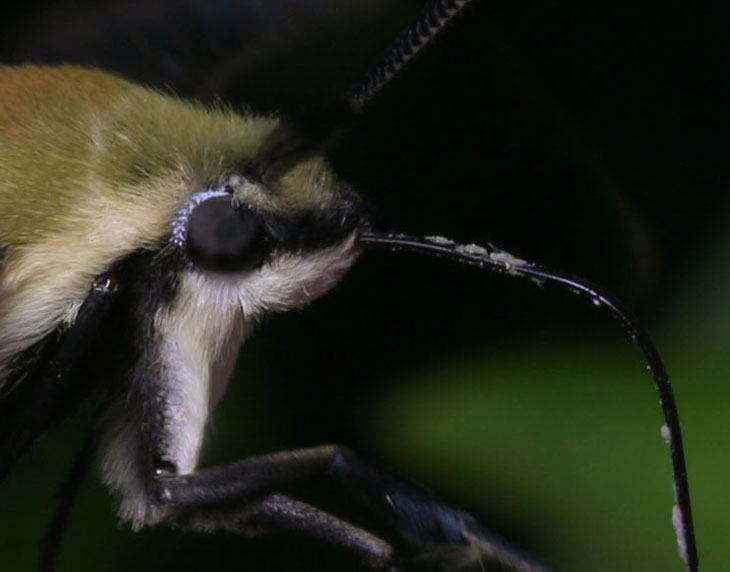



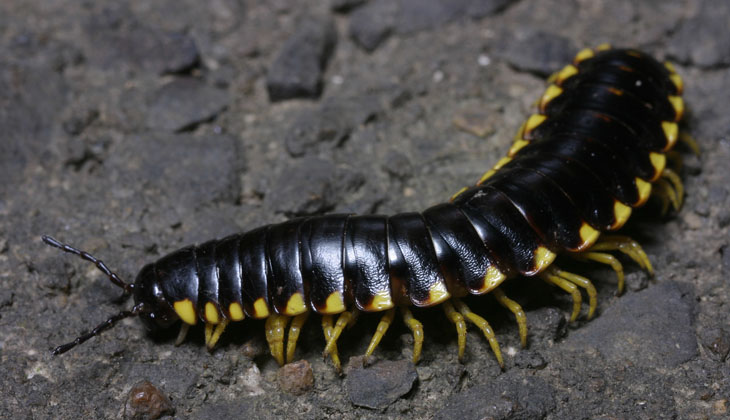
 Carl Zimmer talks about this
Carl Zimmer talks about this 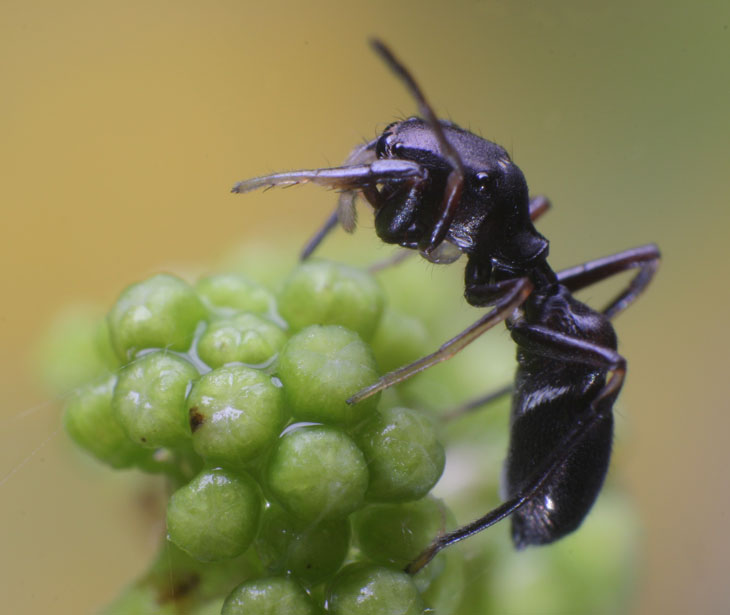
 A few days ago, I’d managed to capture another specimen I’ve been wanting more images of, an ant mimic jumping spider. Only about 5mm long, they really do appear like ants unless you know what to look for. For instance, they only have two body segments – spiders have a fused head and thorax, called a cephalothorax, while ants do not – but to me, it’s easier to spot them from their habits; spiders just move differently from ants. Especially this species, which is highly active for a spider and very difficult to capture in the tiny focus range of macro photography. These images were from my second attempt, the first yielding nothing worth keeping. And these are admittedly studio shots, using a sprig of grape buds held in an alligator clamp, with a little petroleum jelly on the base of the sprig to prevent the spider from escaping (on foot, anyway – there were a few tries at rappelling down on a web strand.) The background is a photo print, close enough to be lit by the same
A few days ago, I’d managed to capture another specimen I’ve been wanting more images of, an ant mimic jumping spider. Only about 5mm long, they really do appear like ants unless you know what to look for. For instance, they only have two body segments – spiders have a fused head and thorax, called a cephalothorax, while ants do not – but to me, it’s easier to spot them from their habits; spiders just move differently from ants. Especially this species, which is highly active for a spider and very difficult to capture in the tiny focus range of macro photography. These images were from my second attempt, the first yielding nothing worth keeping. And these are admittedly studio shots, using a sprig of grape buds held in an alligator clamp, with a little petroleum jelly on the base of the sprig to prevent the spider from escaping (on foot, anyway – there were a few tries at rappelling down on a web strand.) The background is a photo print, close enough to be lit by the same  All of my attempts to pin down this species have failed so far, but I’m leaning towards a member of the genus
All of my attempts to pin down this species have failed so far, but I’m leaning towards a member of the genus  My final subject is
My final subject is 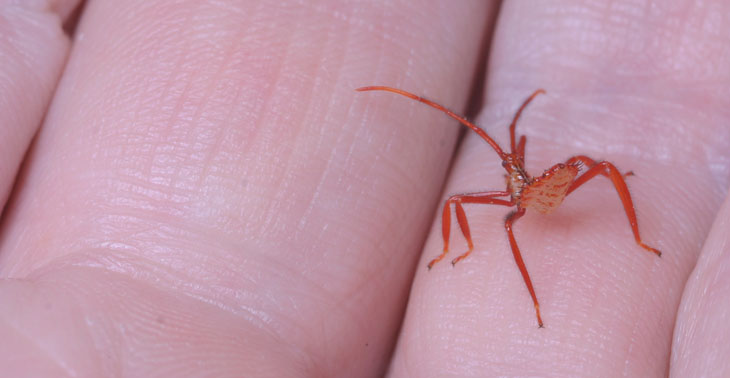



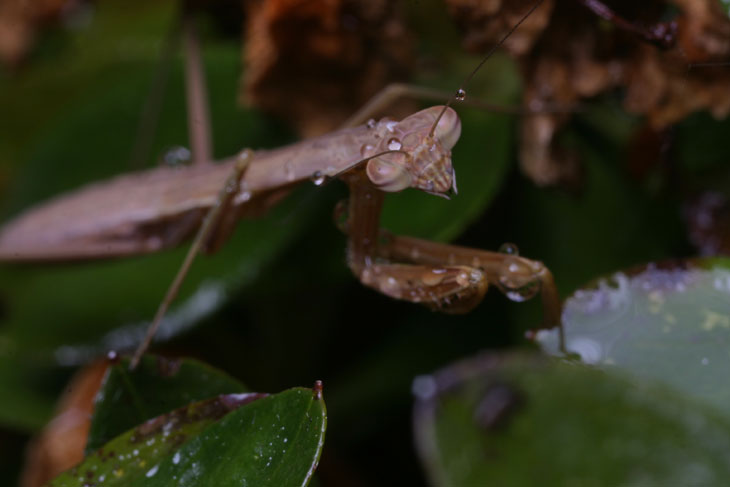

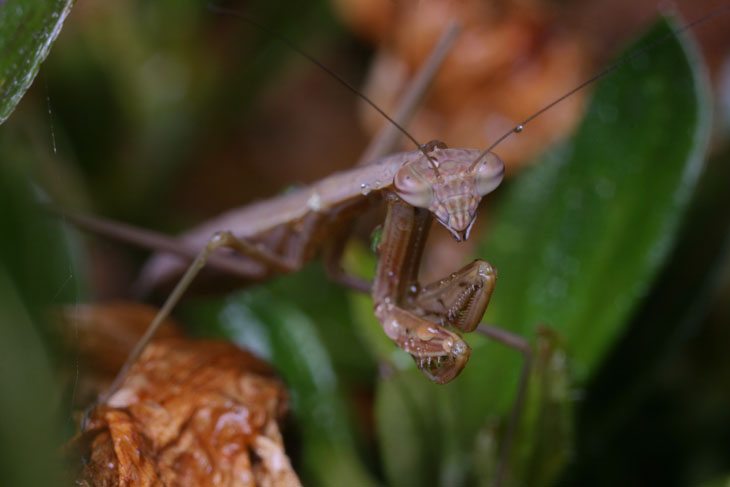
 After dousing the bush, naturally, the rain started later in the evening – yes, the weather report had indicated the possibility, but this is North Carolina, where that’s perhaps even more questionable than other areas of the country. I’ve learned my lesson before by almost killing plants in the garden, waiting for the promised rains that never came, and now water as needed regardless of the threats. The mantises appear quite happy with the rain, sitting well out into the open, and so is another resident. Just yesterday (as I type this draft; probably several days ago now that this post is published,) I was thinking that I hadn’t seen the tiny green lynx spider after that
After dousing the bush, naturally, the rain started later in the evening – yes, the weather report had indicated the possibility, but this is North Carolina, where that’s perhaps even more questionable than other areas of the country. I’ve learned my lesson before by almost killing plants in the garden, waiting for the promised rains that never came, and now water as needed regardless of the threats. The mantises appear quite happy with the rain, sitting well out into the open, and so is another resident. Just yesterday (as I type this draft; probably several days ago now that this post is published,) I was thinking that I hadn’t seen the tiny green lynx spider after that  I’m making this post because I have to face up to my problems if I want to defeat them.
I’m making this post because I have to face up to my problems if I want to defeat them.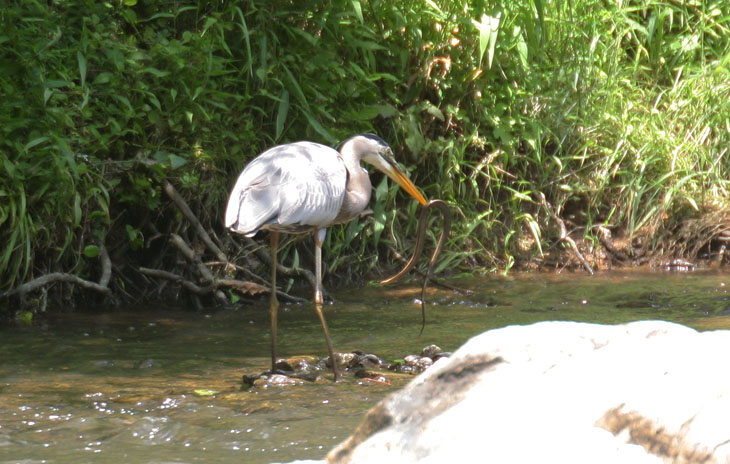


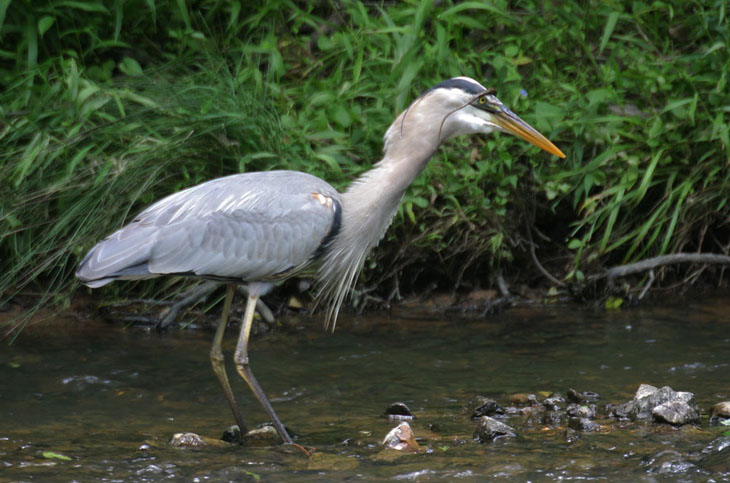
 With a little stretching and internal adjustment, the snake was gone, and if you’re looking at the peculiar shape of the neck and wondering, yeah, so am I; I wish I could tell you more, but I’d only be speculating. Immediately afterward the heron took a couple of drinks of water, possibly because snakes are drier than fish and herons have minimal salivary glands – they just go down better with a chaser. There’s also the possibility that the heron was picking up a few river stones to aid in digestion, but I have not determined yet if they actually do this. Without teeth, most birds have to break up the tougher foods somehow, and this usually occurs in the crop, a kind of pre-stomach at the base of the neck. A few stones or, in the case of smaller birds, some coarse grit added to the crop serves as grinding surfaces to break down their meals for better digestion.
With a little stretching and internal adjustment, the snake was gone, and if you’re looking at the peculiar shape of the neck and wondering, yeah, so am I; I wish I could tell you more, but I’d only be speculating. Immediately afterward the heron took a couple of drinks of water, possibly because snakes are drier than fish and herons have minimal salivary glands – they just go down better with a chaser. There’s also the possibility that the heron was picking up a few river stones to aid in digestion, but I have not determined yet if they actually do this. Without teeth, most birds have to break up the tougher foods somehow, and this usually occurs in the crop, a kind of pre-stomach at the base of the neck. A few stones or, in the case of smaller birds, some coarse grit added to the crop serves as grinding surfaces to break down their meals for better digestion.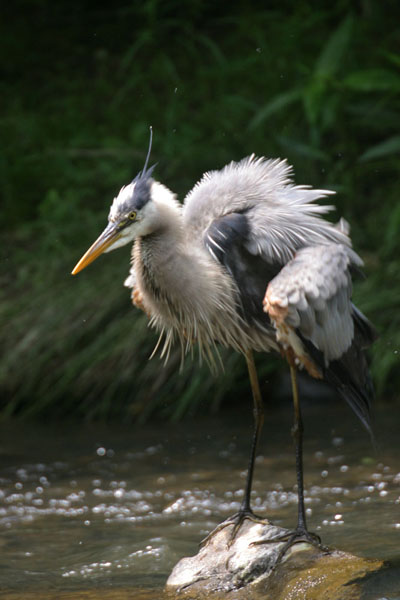 While it might seem ‘easier’ for birds like herons and hawks to simply re-evolve teeth, that’s not how evolution works – even though it might only require a very simple genetic change, since the gene to develop teeth likely remains but is inactive. Genetic change is haphazard, initially random changes, and if it proves to be beneficial to the species it’s more likely to be passed on to the offspring. It could be that a change similar to teeth just didn’t occur again; it could also be that it did occur, but at that point in time it wasn’t useful, since the herons’ ancestor then was not eating snakes and crayfish and such (modern great blue herons will eat about
While it might seem ‘easier’ for birds like herons and hawks to simply re-evolve teeth, that’s not how evolution works – even though it might only require a very simple genetic change, since the gene to develop teeth likely remains but is inactive. Genetic change is haphazard, initially random changes, and if it proves to be beneficial to the species it’s more likely to be passed on to the offspring. It could be that a change similar to teeth just didn’t occur again; it could also be that it did occur, but at that point in time it wasn’t useful, since the herons’ ancestor then was not eating snakes and crayfish and such (modern great blue herons will eat about